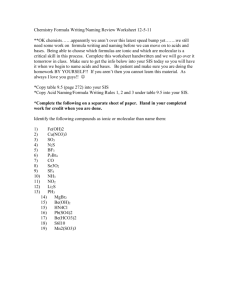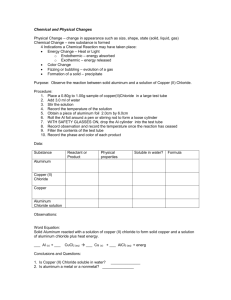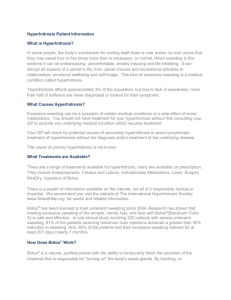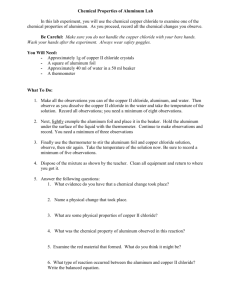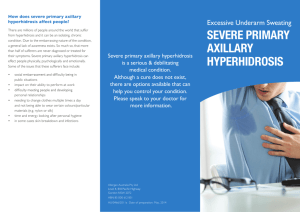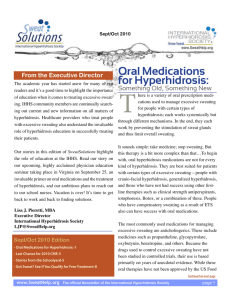Excessive sweating (Hyperhidrosis)
advertisement
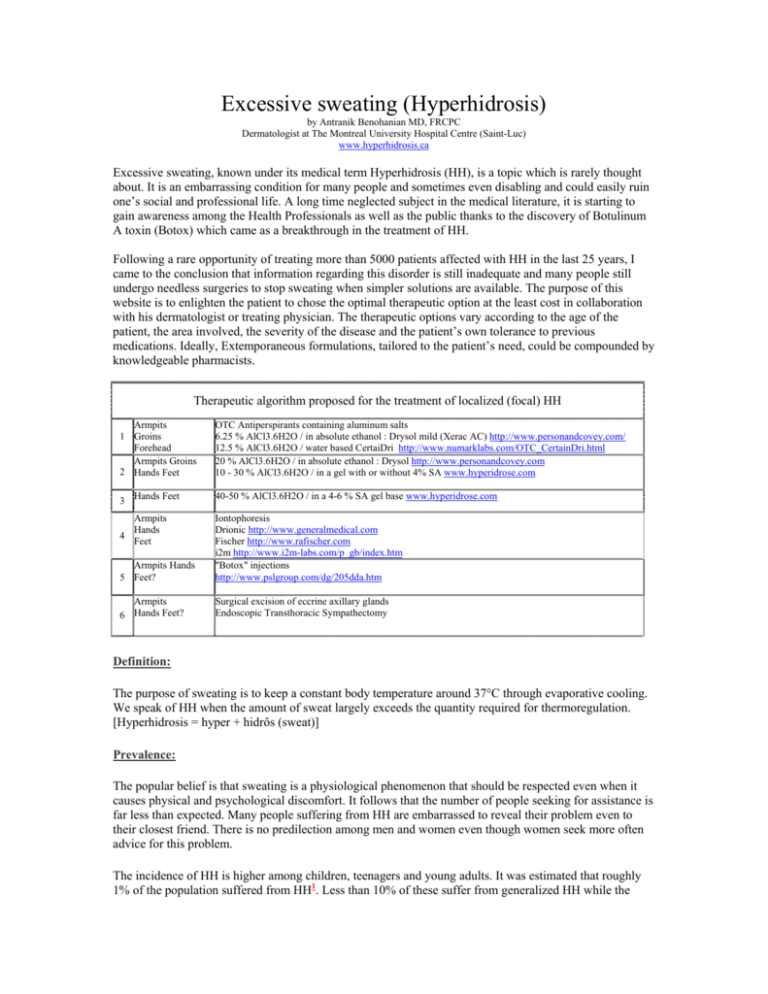
Excessive sweating (Hyperhidrosis) by Antranik Benohanian MD, FRCPC Dermatologist at The Montreal University Hospital Centre (Saint-Luc) www.hyperhidrosis.ca Excessive sweating, known under its medical term Hyperhidrosis (HH), is a topic which is rarely thought about. It is an embarrassing condition for many people and sometimes even disabling and could easily ruin one’s social and professional life. A long time neglected subject in the medical literature, it is starting to gain awareness among the Health Professionals as well as the public thanks to the discovery of Botulinum A toxin (Botox) which came as a breakthrough in the treatment of HH. Following a rare opportunity of treating more than 5000 patients affected with HH in the last 25 years, I came to the conclusion that information regarding this disorder is still inadequate and many people still undergo needless surgeries to stop sweating when simpler solutions are available. The purpose of this website is to enlighten the patient to chose the optimal therapeutic option at the least cost in collaboration with his dermatologist or treating physician. The therapeutic options vary according to the age of the patient, the area involved, the severity of the disease and the patient’s own tolerance to previous medications. Ideally, Extemporaneous formulations, tailored to the patient’s need, could be compounded by knowledgeable pharmacists. Therapeutic algorithm proposed for the treatment of localized (focal) HH Armpits 1 Groins Forehead Armpits Groins 2 Hands Feet OTC Antiperspirants containing aluminum salts 6.25 % AlCl3.6H2O / in absolute ethanol : Drysol mild (Xerac AC) http://www.personandcovey.com/ 12.5 % AlCl3.6H2O / water based CertaiDri http://www.numarklabs.com/OTC_CertainDri.html 20 % AlCl3.6H2O / in absolute ethanol : Drysol http://www.personandcovey.com 10 - 30 % AlCl3.6H2O / in a gel with or without 4% SA www.hyperidrose.com 3 Hands Feet 40-50 % AlCl3.6H2O / in a 4-6 % SA gel base www.hyperidrose.com Armpits Hands 4 Feet Armpits Hands 5 Feet? Iontophoresis Drionic http://www.generalmedical.com Fischer http://www.rafischer.com i2m http://www.i2m-labs.com/p_gb/index.htm "Botox" injections http://www.pslgroup.com/dg/205dda.htm Armpits 6 Hands Feet? Surgical excision of eccrine axillary glands Endoscopic Transthoracic Sympathectomy Definition: The purpose of sweating is to keep a constant body temperature around 37°C through evaporative cooling. We speak of HH when the amount of sweat largely exceeds the quantity required for thermoregulation. [Hyperhidrosis = hyper + hidrôs (sweat)] Prevalence: The popular belief is that sweating is a physiological phenomenon that should be respected even when it causes physical and psychological discomfort. It follows that the number of people seeking for assistance is far less than expected. Many people suffering from HH are embarrassed to reveal their problem even to their closest friend. There is no predilection among men and women even though women seek more often advice for this problem. The incidence of HH is higher among children, teenagers and young adults. It was estimated that roughly 1% of the population suffered from HH1. Less than 10% of these suffer from generalized HH while the great majority suffers from localized HH which may involve the axillae the feet and the hands, in that order of frequency. Rarely, the forehead and the groins are also involved. 25 % of individuals affected with palmar or plantar HH have also axillary HH2. Family history is often positive. A recent survey indicated that the prevalence of HH3 in the U.S. population is 2.8%. This means about 8 million individuals in the USA and 800,000 in Canada. Over 60% of these cases never consulted their health care provider. The survey revealed also that armpits are affected in about 50% of the cases while the hands in only 25%. Nine out of ten North Americans use an antiperspirant4 or deodorant on a daily basis. These products fail to control most cases of HH. The Impact of HH on the quality of life5 A recent study conducted by Naumann & al. revealed that the quality of life in individuals suffering from HH is not affected in 8% of the cases, occasionally affected in 54% of the cases, often affected in 26% of the cases and permanently affected in 12% of the cases. 75% of the people surveyed had to change their clothing many times a day. The great majority of this group avoided family and social gatherings from fear of disclosing their condition. On the feet, HH represents a favourite medium to trigger a host of dermatological diseases such as : pitted keratolysis, bromhidrosis6, tinea pedis7, eczema, dyshidrotic eczema (pompholyx) 8, contact dermatitis9, friction blisters10,11, warts1210, frostbites in skiers and outside workers in sub zero temperatures, soft calluses between the 4th and 5th toes13 and even ingrown nails14. On the other hand, shoes will be burnt and destroyed by the sweat at an accelerated rate15. There has been a case report where combined Gram negative and fungal infections on the feet have resisted intravenous antibiotics in the presence of HH16. On the hands HH can stain books and papers, makes the fingers slippery on computer keyboards and even prevents us from playing our favourite sports like baseball golf or tennis. Slippery hands can easily drop objects and manual work becomes difficult and prone to injury because of the difficulty in holding instruments safely. People with sweaty palms will not qualify for certain jobs like hairdressing or healthcare. A moist and cold handshake will not inspire confidence in a job interview. Other jobs like working in a cafeteria or a bakery will be difficult. HH may even disable mucisians17. Politicians and speakers who sweat will have a hard time to convey their message to their audience because sweat conveys anxiety and lack of confidence if not incompetence. On the armpits HH will stain and ruin expensive clothing besides causing tremendous embarrassment. Localized (focal) HH HH is arbitrarily classified as focal or localized, if it does not exceed an area of 100cm2, and generalized if it does exceed 100 cm2 18. Focal HH is also known as primary, idiopathic or essential HH. Sweating is often triggered by anxiety and fear. Certain substances will also trigger HH like coffee, tea, cola drinks, 2 chocolate and spices. In this type of HH, the armpits, the hands and feet are most often involved, but the forehead, the groins and the perineum could also be affected. Primary HH is almost always symmetrical. An asymmetrical HH should always raise suspicious of an underlying pathology. The sweat glands are most active during the day. Generalized HH Generalized HH occurs following fever, exercise, an increase in air temperature and other triggers such as, anxiety, spicy foods and many drugs. Sweating, like fever and shivering, is one of the main signs and symptoms that allow us to reach an accurate diagnosis during the assessment of many diseases. Several specialties like internal medicine, endocrinology, neurology, neurosurgery, dermatology and psychiatry to name only a few, are often implicated in its evaluation. Night sweats are more commonly associated with infection, classically tuberculosis, brucellosis or even a lymphoma. The diagnosis of HH poses no problem as the sweat droplets on the affected area or the staining of the clothing covering that same area are more than enough to confirm it. The control of sweating Sweat is secreted by the eccrine glands, present all over the body, that play an important role in thermoregulation. People devoid of sweat glands have a hard time in maintaining a stable body temperature. However, some areas, like the palms and soles do not really contribute to this thermoregulation19. Sweating in these areas is triggered more by emotions then heat. Moreover, in individuals who are somewhat emotional, "flushing" adds up, making an already embarrassing situation even worse. There are about 3 millions sweat glands, of the eccrine type, covering our skin surface from head to toe. Their density varies from one part to another. The back contains 64 glands /cm2, the forearm 108 glands/ cm2, and the forehead 181 glands/ cm2. The palms and soles contain each from 600 to 700 glands / cm2. The thermostat that regulates the body temperature is located in the hypothalamus. When the body temperature rises beyond a certain level, sweating is activated through the sympathetic nervous system and the nerve terminals responsible for the sweat secretion. In the case of primary HH, nerve impulses triggered by emotions may reach the hypothalamus that activates the sweat process. Medications and toxic agents triggering HH: Among the most important triggers are: pilocarpine, physostigmine, acetaminophen, aspirin, insulin, niacin, antidepressants, meperidine, tamoxifen. Alcohol and alcohol withdrawal syndrome, opiates and cocaine may also trigger sweating. Systemic Treatment Psychotherapy: Sometimes a minor sedative that controls the stress is enough to stop the sweating. But, this measure will induce only a partial remission. Some individuals may respond better to medications like amitriptyline and hydroxyzine which have sedative or anticholinergic effect, while others respond to "Biofeedback". Anticholinergic agents: Sweat is activated by post-ganglionic sympathetic fibres which behave like parasympathetic or cholinergic fibres. 3 Glycopyrrolate (Robinul) Propantheline (Pro-Banthine) Oxybutynin Hydrochloride (Ditropan) 1 to 2 mg tid prn 7.5 mg tid prn 5mg tid prn Draw backs of anticholinergics: Unfortunately, the anti-cholinergic effects generated by these medications are worse than the sweating itself: tachycardia, dry mouth, sluggishness of the intestinal motility, worsening of certain conditions like: glaucoma, toxic erythema, convulsions etc... Moreover, these symptoms appear long before the sweat is under control. It follows that anticholinergics have little place in the management of HH. There are reports in the literature where cases have responded to the following medications: Indomethacine (indocid) Diltiazem (cardizem) Clonidine (Catapres) Propranolol (Inderal) Oxprenolol (Trasicor) 25 mg tid20 30 to 60 mg tid21 0.1mg BID 20mg TID 20 mg TID Treatment of localized HH Antiperspirants and deodorants The aim of an antiperspirant is to decrease the amount of sweating by creating a plug in the acrosyringium. The plug is made of aluminum salts. Deodorants, on the other hand are products aimed at decreasing the odour with an antibacterial agent or masking it with a perfume. Aluminum chlorhydrate Present in most antiperspirants available over the counter. Its concentration is higher in antiperspirants than in deodorants. Among the aluminum salts, aluminum chloride is the most effective followed by aluminum chlorhydrate / zinc compounds and finally aluminum chlorhydrate used alone. Aluminum chloride hexahydrate in an alcoholic solution Aluminum chloride hexahydrate is available as a 20% alcoholic solution Drysol® and at 6% concentration under the name Xerac ac®. Aluminum chloride hexahydrate has to be used in a distinctive way. The armpits, hands and feet must be thoroughly washed and blow dried before its application. The solution is applied under occlusion with Cellophane paper in resistant cases. Gloves may be used for the hands and plastic bags for the feet. Occlusion is kept overnight. This procedure is repeated 2 to 3 nights per week. Irritation is a common side effect. Stinging and burning sensation are common at the beginning but may subside after a while22. Aluminum Chloride Hexahydrate in a salicylic acid gel base In 1978, Aluminum Chloride Hexahydrate in a salicylic acid gel base was first used in a middle aged woman suffering from axillary HH on the verge of getting a surgery to get rid of her axillary glands after 4 failing to respond to Drysol under occlusion. The outcome was impressive. Her surgery has been cancelled and over a 100 similar cases were referred to me during that same year. The extemporaneous formulation of 20% Aluminum chloride in a 4% Salicylic Acid Gel Base Ingredients Weight Compounding steps Aluminum 20g 1. Grind 20 grams of aluminum chloride hexahydrate in a mortar until Chloride a fine powder is obtained. hexahydrate 2. Mix this powder with 10 ml of absolute ethanol and grind more. Absolute ethanol 10ml 3. Add the former mixture slowly (i.e. over a 10 minutes period) to Salicylic acid gel 100g SAGB, grinding all the way through with each addition. 4. Keep this formulation refrigerated. 4% salicylic acid gel base preparation (similar to but not identical with Keralyt) qs 100 g Ingredients Weight Compounding steps Salicylic Acid USP 4g 1. SA Salicylic Acid / ethanol: dissolve 4 grams of Salicylic Acid in 5-10 ml of absolute ethanol. Propylene glycol 60g 2. 3g a. Dampen 3.0 g of hydroxy propyl cellulose 1500 CPS powder with propylene glycol and mix until the combination becomes a paste. 100g b. Add the balance of propylene glycol slowly to the paste to have a total weight of approximately 63 g of a lump free mixture. Hydroxypropylcellulose 1500 CPS Absolute ethanol qs ad Propylene glycol - hydroxy propyl cellulose mixture. 3. Mix the Salicylic Acid / ethanol with Propylene glycol hydroxy propyl cellulose mixture and add absolute alcohol to have a final weight of 100g. The advantage of alcohol gel over the alcohol solution Even though absolute ethanol ( 95%) has been the traditional vehicle in which aluminum chloride hexahydrate has been dissolved for a great number of years, the fact remains that alcohol may cause an unbearable irritation in some patients. There are few reports that testify that alcohol gels are less irritating and better tolerated than alcohol solutions24,25. Moreover, aluminum chloride in its alcoholic base does not penetrate adequately through the thick horny layers present on the palms and soles to exert its antiperspirant effect26. The role of salicylic acid in this formulation is to enhance the penetration of aluminum chloride through the thick horny layers and, having antiperspirant properties of its own27, it could act synergistically with aluminum chloride to enhance the required antiperspirant effect28. Occlusion with Cellophane paper becomes unnecessary with this formulation. Aluminum salts create a plug at the end of the sweat duct (acrosyringium) near the skin surface which will induce structural changes in the axillary eccrine glands on the long run29, thus diminishing the sweat flow 5 which in its turn will diminish the need for antiperspirants. Treatment with this formulation could be as rare as once a month. The following factors should be taken into account when prescribing aluminum chloride formulations: the age of the patient, the affected site, the severity of HH and the patient’s tolerance. The concentration of aluminum chloride should be adjusted accordingly. Treatment with Botulinum Toxin Type A injections On September 10, 2001 Health Canada approved Botox® (Botulinum Toxin Type A) for axillary HH, thus giving new hope for people who after failing to respond to topical treatments were compelled to face surgery. The technique is quite simple: the physician identifies the hyperactive sweat area or areas with Minor’s Starch Iodine test and then, 10 to 15 sites, approximately 2 cm apart, are injected into each axilla. This procedure used to be more painful when Botulinum toxin A was reconstituted in saline devoid of preservative. Recent studies have proven that Botox reconstituted in saline containing preservative, like benzyl alcohol, the injections were much less painful. The whole procedure may take about 20 minutes including the Botox preparation. Botox acts by blocking acetyl choline release at the nerve endings that stimulate the sweat glands thus shutting down the sweat process on the injected sites like the armpits30, hands31 or feet. Topical anticholinergic medications Topical glycopyrrolate as 0.5% aqueous solution has been reported also to control HH of the forehead32. Conclusion HH is well known for its devastating role on the quality of life of its victims. Recent estimates confirm that this disease affects a much larger proportion of individuals in the U.S. than previously thought. The control of HH, regardless of the treatment option, restores dramatically the quality of life of its victims. Most of the time, simple remedies achieve that goal. In Canada, a vast HH awareness campaign has been launched together with the Canadian hyperhidrosis treatment centres www.sweatmanagement.ca to deal with this problem. It is desirable that other countries follow this trend to ensure a brighter future to HH sufferers throughout the world References : 1. 2. 3. 4. 5. 6. 7. 8. 9. 10. 11. 12. 13. 14. 15. Adar R. Zurchin A, Zweig A,Mozes M. Palmar hyperhidrosis and its surgical treatment: a report of 100 cases. Ann Surg. 1977.186:34-41 Sato K. Biology of sweat glands and their disorders II. Disorders of sweat gland function J Am Acad Dermatol 1989.20:713-726 Strutton DR, Kowalski JW, Glaser DA, Stang PE. U.S. Prevalence of Hyperhidrosis: Results from a National Survey. 2003, AAD poster P-362 Benohanian A. Antiperspirants and Deodorants. Clin Dermatol. 2001;19(4):398-405. Naumann MK, Lowe NJ. Effect of botulinum toxin type A on quality of life measures in patients with excessive axillary sweating: a randomized controlled trial. Br J Dermatol. 2002 Dec;147(6):1218-26 Takama H; Tamada Y; Yano K; Nitta Y; Ikeya T. Pitted keratolysis: clinical manifestations in 53 cases. Br J Dermatol 1997;137:282-5 Stratigos AJ; Stern R; Gonzalez E; Johnson RA; O'Connell J; Dover JS. Prevalence of skin disease in a cohort of shelter-based homeless men. J Am Acad Dermatol 1999;41:197-202 Yokozeki H; Katayama I; Nishioka K; Kinoshita M; Nishiyama S. The role of metal allergy and local hyperhidrosis in the pathogenesis of pompholyx. J Dermatol 1992;19:964-7 Berndt U; Hinnen U; Iliev D; Elsner P. Is occupational irritant contact dermatitis predictable by cutaneous bioengineering methods? Results of the Swiss Metalworkers' Eczema Study (PROMETES). Dermatology 1999;198:351-4 Knapik JJ; Reynolds K; Barson J. Influence of an antiperspirant on foot blister incidence during cross-country hiking. J Am Acad Dermatol. 1998;39:202-6 Benohanian A; Dansereau A. Influence of an antiperspirant on foot blister incidence during cross-country hiking. J Am Acad Dermatol. 1999;41:655-6 Mergler D; Vezina N; Beauvais A. Warts among workers in poultry slaughterhouses. Scand J Work Environ Health 1982;8 Suppl 1:180-4 Singh D, Bentley G, Trevino SG. Fortnightly Review: Callosities, corns, and calluses. BMJ 1996;312:1403-1406 Steigleder GK; Stober-Munster I. [Syndrome of the ingrown nails?] Z Hautkr 1977;52:1225-9 Freeman S. Shoe dermatitis. Contact Dermatitis 1997 May;36(5):247-51 6 16. 17. 18. 19. 20. 21. 22. 23. 24. 25. 26. 27. 28. 29. 30. 31. 32. Shelley WB; Shelley ED. Recalcitrant unilateral infection associated with congenital leg hypertrophy cleared by control of hyperhidrosis. Cutis 1984 Mar;33(3):281-2 Onder M; Aksakal AB; Oztas MO; Gurer MA. Skin problems of musicians. Int J Dermatol 1999;38:192-5 Sato K; Ohtsuyama M; Samman G. Eccrine sweat gland disorders. J Am Acad Dermatol 1991;24:1010-4 Kerassidis S. Is palmar and plantar sweating thermoregulatory? Acta Physiol Scand 1994;152:259-63 Goldyne ME: Indomethacin and Hyperhidrosis. (Letter) J Am Acad Dermatol1982. 6: 545 James WD, Schoomaker EB, Rodman OG. Emotional eccrine sweating. Arch Dermatol 1987.123:925-9 Shelley WB; Hurley HJ Jr. Studies on topical antiperspirant control of axillary hyperhidrosis. Acta Derm Venereol 1975;55(4):241-60 Benohanian, A: La bromidrose. Le Clinicien1996;11(10):131-152 Comes DA, Dolan MJ, Fendler EJ, Turner TK, Williams RA.Effects of alcohol on human skin: AAD poster 1997 Newman JL, Seitz JC.Intermittent use of an antimicrobial hand gel for reducing soap-induced irritation of health care personnel: Am J Infect Control, 1990 Juin, 18:3,194-200 White JW. Treatment of primary hyperhidrosis. Mayo Clin Proc1986. 61:951-6 Martindale, the Pharmaceutical Press. The extra Pharmacopoeia, 27th edition 212-213 Benohanian A; Dansereau A; Bolduc C; Bloom E. Localized hyperhidrosis treated with aluminum chloride in a salicylic acid gel base. Int J Dermatol. 1998.;37:701-3Int J Dermatol. 1998;37:701-3 Hölzle E, Braun-Falco O: Structural changes in axillary eccrine glands following long-term treatment with aluminium chloride hexahydrate solution. Br J Dermatol 1984.110:339-403 Bushara KO, Park DM, Jones JC, Schutta HS. Botulinum toxin, a possible new treatment for axillary hyperhidrosis. Clin Exp Dermatol, 1996 July, 21:4, 2768 Schnider P, Binder M, Auff E, Kittler H, Burger T, Wolff K. Double-blind trial of botulinum A toxin for the treatment of focal hyperhidrosis of the palms. Br J Dermatol. 1997 Apr;136(4):548-52 Seukeran DC; Highet AS. The use of topical glycopyrrolate in the treatment of hyperhidrosis. Clin Exp Dermatol 1998 Sep;23(5):204-5. 7

